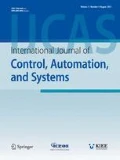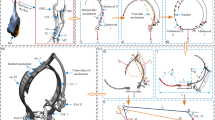Abstract
Considering formation control of multi-UAV system subject to input saturation, the issue of achieving predefined configuration in a distributed finite-time event-triggered scheme is investigated. Precise feedback linearization based on differential geometry theory is utilized to linearize the nonlinear motion model of unmanned aerial vehicles. A fixed-time convergent observer is skillfully constructed to estimate the leader’s velocity information with accuracy and quickness. A novel distributed event-triggered finite-time formation control protocol incorporated by saturation functions is proposed to achieve the desired formation in finite time. An estimation of the finite-settling time is conducted by subtly constructing the Lyapunov function. Rigorous proof shows the finite-time stability of the formation control algorithm, boundedness of the control inputs and non-existence of the unexpected Zeno behavior. Numerical simulations are performed to demonstrate the effectuality of the theoretical results.
Similar content being viewed by others
References
K. K. Oh, M. C. Park, and H. S. Ahn, “A survey of multi-agent formation control,” Automatica, vol. 53, pp. 424–440, Mar 2015.
G. Liu and S. Zhang, “A survey on formation control of small satellites,” Proceedings of the IEEE, vol. 106, pp. 440–457, Mar 2018.
S. Chung, A. A. Paranjape, P. Dames, S. Shen, and V. Kumar, “A survey on aerial swarm robotics,” IEEE Transactions on Robotics, vol. 34, pp. 837–855, Aug 2018.
U. K. Verfuss, A. S. Aniceto, D. V. Harris, D. Gillespie, S. Fielding, G. Jiménez, P. Johnston, R. R. Sinclair, A. Sivertsen, S. A. Solbø, R. Storvold, M. Biuw, and R. Wyatt, “A review of unmanned vehicles for the detection and monitoring of marine fauna,” Marine Pollution Bulletin, vol. 140, pp. 17–29, Mar 2019.
A. Mairaj, A. I. Baba, and A. Y. Javaid, “Application specific drone simulators: Recent advances and challenges,” Simulation Modelling Practice and Theory, vol. 94, pp. 100–117, Jul 2019.
H. T. Lally, I. O’Connor, O. P. Jensen, and C. T. Graham, “Can drones be used to conduct water sampling in aquatic environments. A review,” Science of the Total Environment, vol. 670, pp. 569–575, Jun 2019.
X. W. Dong, Y. Z. Hua, Y. Zhou, Z. Ren, and Y. S. Zhong, “Theory and experiment on formation-containment control of multiple multirotor unmanned aerial vehicle systems,” IEEE Transactions on Automation Science and Engineering, vol. 16, pp. 229–240, Jan 2019.
Z. P. Yan, D. Xu, T. Chen, W. Zhang, and Y. B. Liu, “Leader-follower formation control of UUVs with model uncertainties, current disturbances, and unstable communication,” Sensors, vol. 18, p. 24, Feb 2018.
Y. Cheng, R. Jia, H. Du, G. Wen, and W. Zhu, “Robust finite-time consensus formation control for multiple non-holonomic wheeled mobile robots via output feedback,” International Journal of Robust and Nonlinear Control, vol. 28, pp. 2082–2096, Apr 2018.
K. K. Oh and H. S. Ahn, “Leader-follower type distance-based formation control of a group of autonomous agents,” International Journal of Control Automation and Systems, vol. 15, pp. 1738–1745, Aug 2017.
S. D. He, M. Wang, S. L. Dai, and F. Luo, “Leader-follower formation control of USVs with prescribed performance and collision avoidance,” IEEE Transactions on Industrial Informatics, vol. 15, pp. 572–581, Jan 2019.
X. Jin, “Nonrepetitive leader-follower formation tracking for multiagent systems with los range and angle constraints using iterative learning control,” IEEE Transactions on Cybernetics, vol. 49, pp. 1748–1758, May 2019.
J. Yang, X. Wang, and P. Bauer, “V-shaped formation control for robotic swarms constrained by field of view,” Applied Sciences-Basel, vol. 8, p. 17, Nov 2018.
G. Lee and D. Chwa, “Decentralized behavior-based formation control of multiple robots considering obstacle avoidance,” Intelligent Service Robotics, vol. 11, pp. 127–138, Jan 2018.
P. P. Zhang and M. de Queiroz, “3D multi-agent formation control with rigid body maneuvers,” Asian Journal of Control, vol. 21, pp. 1088–1099, May 2019.
X. Dong and G. Hu, “Time-varying formation tracking for linear multiagent systems with multiple leaders,” IEEE Transactions on Automatic Control, vol. 62, pp. 3658–3664, Feb 2017.
Y. Wang, Z. S. Cheng, and M. Xiao, “UAVs’ formation keeping control based on multi-agent system consensus,” IEEE Access, vol. 8, pp. 49000–49012, 2020.
M. F. Hassan and M. Hammuda, “Leader-follower formation control of mobile nonholonomic robots via a new observer-based controller,” International Journal of Systems Science, vol. 51, pp. 1243–1265, May 2020.
J. Lu, F. Chen, and G. R. Chen, “Nonsmooth leader-following formation control of nonidentical multi-agent systems with directed communication topologies,” Automatica, vol. 64, pp. 112–120, Feb 2016.
L. Q. Dou, C. Yang, D. D. Wang, B. L. Tian, and Q. Zong, “Distributed finite-time formation control for multiple quadrotors via local communications,” International Journal of Robust and Nonlinear Control, pp. 5588–5608, Nov 2019.
E. J. Zhao, T. Chao, S. Y. Wang, and M. Yang, “Finite-time formation control for multiple flight vehicles with accurate linearization model,” Aerospace Science and Technology, vol. 71, pp. 90–98, Dec 2017.
F. Mehdifar, F. Hashemzadeh, M. Baradarannia, and M. de Queiroz, “Finite-time rigidity-based formation maneuvering of multiagent systems using distributed finite-time velocity estimators,” IEEE Transactions on Cybernetics, vol. 49, pp. 4473–4484, Oct. 2019.
Z. Y. Gao and G. Guo, “Velocity free leader-follower formation control for autonomous underwater vehicles with line-of-sight range and angle constraints,” Information Sciences, vol. 486, pp. 359–378, Jun 2019.
L. Ding, Q. Han, X. Ge, and X. Zhang, “An overview of recent advances in event-triggered consensus of multiagent systems,” IEEE Transactions on Cybernetics, vol. 48, pp. 1110–1123, Nov 2017.
J. Liu, J. A. Fang, Z. Li, and G. He, “Formation control with multiple leaders via event-triggering transmission strategy,” International Journal of Control Automation and Systems, vol. 17, pp. 1494–1506, Jun 2019.
Z. R. Cao, C. D. Li, X. Wang, and T. W. Huang, “Finite-time consensus of linear multi-agent system via distributed event-triggered strategy,” Journal of the Franklin Institute-Engineering and Applied Mathematics, vol. 355, pp. 1338–1350, Feb 2018.
C. Du, X. Liu, W. Ren, P. Lu, and H. Liu, “Finite-time consensus for linear multiagent systems via event-triggered strategy without continuous communication,” IEEE Transactions on Control of Network Systems, vol. 7, pp. 19–29, 2020.
X. Jin, D. Wei, W. He, L. Kocarev, Y. Tang, and J. Kurths, “Twisting-based finite-time consensus for euler-lagrange systems with an event-triggered strategy,” IEEE Transactions on Network Science and Engineering, vol. 7, no. 3, pp. 1007–1018, 2020.
J. Liu, Y. Zhang, H. Liu, Y. Yu, and C. Sun, “Robust event-triggered control of second-order disturbed leader-follower MASs: A nonsingular finite-time consensus approach,” International Journal of Robust and Nonlinear Control, vol. 29, pp. 4298–4314, Sep 2019.
A. Zhang, D. Zhou, P. Yang, and M. Yang, “Event-triggered finite-time consensus with fully continuous communication free for second-order multi-agent systems,” International Journal of Control Automation and Systems, vol. 17, pp. 836–846, Apr 2019.
J. Y. Yang, F. Xiao, and T. W. Chen, “Event-triggered formation tracking control of nonholonomic mobile robots without velocity measurements,” Automatica, vol. 112, p.11, Feb 2020.
Z. Zhou, H. B. Wang, and Z. Q. Hu, “Event-based time varying formation control for multiple quadrotor UAVs with markovian switching topologies,” Complexity, p. 16, Apr 2018.
R. R. Nair, L. Behera, and S. Kumar, “Event-triggered finite-time integral sliding mode controller for consensus-based formation of multirobot systems with disturbances,” IEEE Transactions on Control Systems Technology, vol. 27, pp. 39–47, Jan 2019.
Z. Gao and G. Guo, “Fixed-time leader-follower formation control of autonomous underwater vehicles with event-triggered intermittent communications,” IEEE Access, vol. 6, pp. 27902–27911, May 2018.
A. Zhang, D. Zhou, M. Yang, and P. Yang, “Finite-time formation control for unmanned aerial vehicle swarm system with time-delay and input saturation,” IEEE Access, vol. 7, pp. 5853–5864, Dec 2019.
Z. H. Zhu and Y. Guo, “Adaptive coordinated attitude control for spacecraft formation with saturating actuators and unknown inertia,” Journal of the Franklin Institute-Engineering and Applied Mathematics, vol. 356, pp. 1021–1037, Jan 2019.
J. Li, J. L. Du, and W. J. Chang, “Robust time-varying formation control for underactuated autonomous underwater vehicles with disturbances under input saturation,” Ocean Engineering, vol. 179, pp. 180–188, May 2019.
F. Liu, Y. Hua, X. Dong, Q. Li, and Z. Ren, “Adaptive fault-tolerant time-varying formation tracking for multi-agent systems under actuator failure and input saturation,” ISA Transactions, vol. 104, pp. 145–153, 2020.
Z. Zheng, M. Qian, P. Li, and H. Yi, “Distributed adaptive control for UAV formation with input saturation and actuator fault,” IEEE Access, vol. 7, pp. 144638–144647, May 2019.
M. Y. Fu and L. L. Yu, “Finite-time extended state observer-based distributed formation control for marine surface vehicles with input saturation and disturbances,” Ocean Engineering, vol. 159, pp. 219–227, Jul 2018.
Y. Huang and Y. M. Jia, “Distributed finite-time output feedback synchronisation control for six DOF spacecraft formation subject to input saturation,” IET Control Theory and Applications, vol. 12, pp. 532–542, Mar 2018.
J. Liu, J. Fang, Z. Li, and Q. Miao, “Event-triggering formation tracking for second-order multi-agent systems subjected to input saturation,” IEEE Access, pp. 138378–138390, Jul. 2019.
S. Bhat and D. Bernstein, “Finite-time stability of continuous autonomous systems,” SIAM Journal on Control and Optimization, vol. 38, pp. 751–766, Mar 2000.
C. Sun, G. Q. Hu, L. H. Xie, and M. Egerstedt, “Robust finite-time connectivity preserving coordination of second-order multi-agent systems,” Automatica, vol. 89, pp. 21–27, Mar 2018.
A. Zhang, P. Yang, and D. Zhou, “Event-triggered finite-time consensus control under uncertain disturbances with fully continuous communication and chattering free,” Transactions of the Institute of Measurement and Control, vol. 42, pp. 228–243, Jan. 2020.
Author information
Authors and Affiliations
Corresponding author
Additional information
Recommended by Editor Hyo-Sung Ahn.
This work was supported by the National Natural Science Foundation of China (Grant No.61903305), Aeronautical Science Fund (ASF, 201905053001), Key Laboratory Open Foundation of Data Link Technology (CLDL-20182113) and Research Funds for Interdisciplinary Subject, NWPU.
Pan Yang received her B.S. degree in electrical engineering and automation from Northwestern Polytechnical University of China, Xi’an, in 2017. She is currently working toward a Ph.D. degree in the Department of Integrated Technology and Control Engineering at Northwestern Polytechnical University, Xi’an. Her current interests include distributed UAV formation control and consensus of multi-agent systems.
An Zhang received his M.S. degree in systems engineering in 1986 and a Ph.D. degree in control theory and control engineering from Northwestern Polytechnical University of China, Xi’an, in 1999. He is currently a full-time professor in Northwestern Polytechnical University, Xi’an. His current research interests include multi-agent systems, UAV formation control and intelligent control.
Ding Zhou received his B.S. and M.S. degrees in control engineering from Northwestern Polytechnical University of China, Xi’an, in 2014 and 2017, respectively. He is currently pursuing his Ph.D. degree in the Department of Integrated Technology and Control Engineering at Northwestern Polytechnical University, Xi’an. His current research interests include multi-agent systems, UAV formation control and event-triggered control.
Publisher’s Note
Springer Nature remains neutral with regard to jurisdictional claims in published maps and institutional affiliations.
Rights and permissions
About this article
Cite this article
Yang, P., Zhang, A. & Zhou, D. Event-triggered Finite-time Formation Control for Multiple Unmanned Aerial Vehicles with Input Saturation. Int. J. Control Autom. Syst. 19, 1760–1773 (2021). https://doi.org/10.1007/s12555-019-0833-7
Received:
Revised:
Accepted:
Published:
Issue Date:
DOI: https://doi.org/10.1007/s12555-019-0833-7




